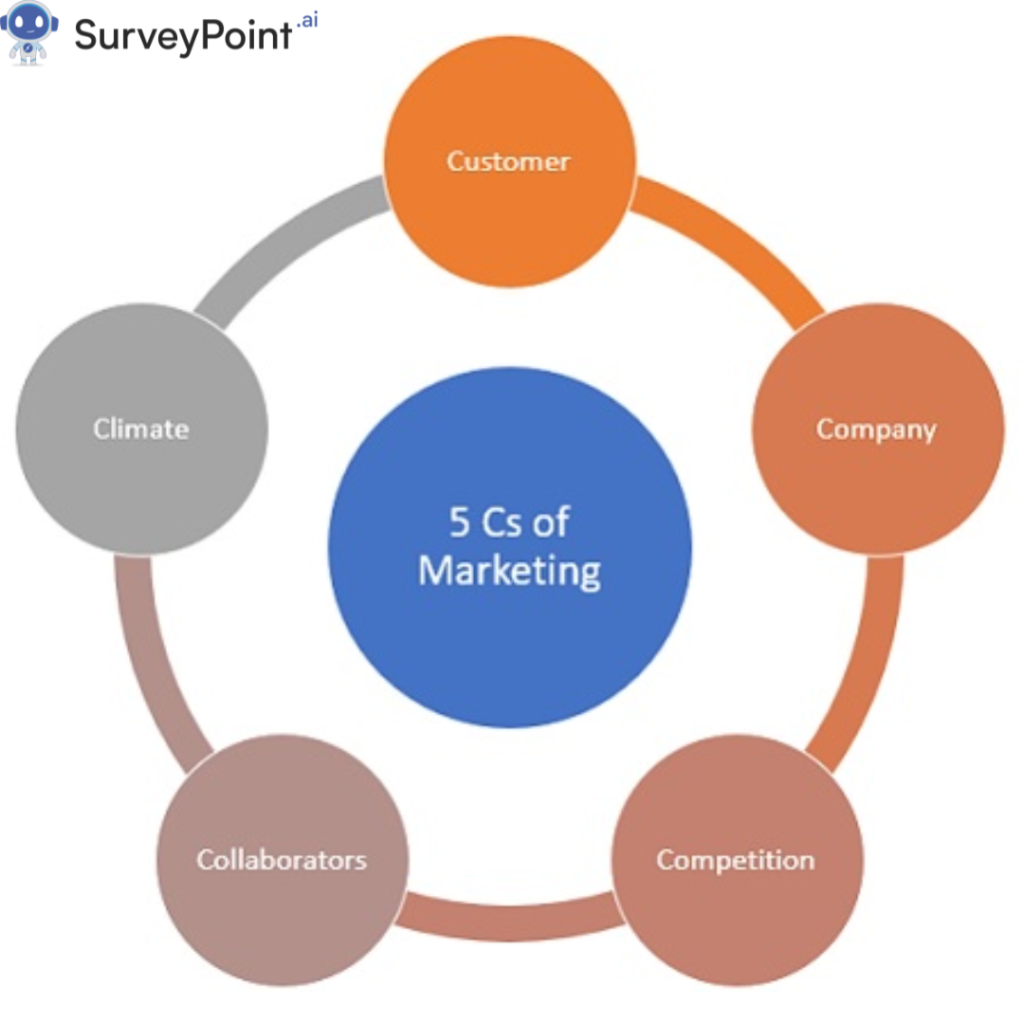
In the ever-evolving world of marketing, understanding the fundamental principles is crucial for developing effective strategies. One such framework that has stood the test of time is the Five C’s of Marketing. This model provides a comprehensive approach to analyzing the critical elements that influence marketing decisions. The Five C’s—Customer, Company, Competitors, Collaborators, and Context—serve as a roadmap for marketers to navigate the complexities of the market and make informed choices. In this blog, we will delve into each of these components and explore how they contribute to successful marketing strategies.
1. Customer
Understanding Your Target Audience
The first and most crucial C in the marketing framework is the Customer. Understanding your target audience’s needs, preferences, and behaviors is essential for creating products and services that resonate with them. Here’s how to get a deep understanding of your customers:
- Market Research: Conduct surveys, focus groups, and interviews to gather insights directly from your potential customers.
- Customer Segmentation: Divide your market into distinct segments based on demographics, psychographics, geographic, and behavioral factors. This helps in tailoring your marketing efforts to specific groups.
- Customer Personas: Create detailed customer personas that represent your ideal customers. These personas should include information such as age, gender, occupation, interests, and purchasing behavior.
Meeting Customer Needs
Once you understand your target audience, focus on meeting their needs and exceeding their expectations. This involves continuous feedback loops and adapting your offerings based on customer feedback.
2. Company
Assessing Your Strengths and Weaknesses
The second C is the Company. To craft effective marketing strategies, you need a thorough understanding of your company’s strengths, weaknesses, resources, and capabilities. This internal analysis helps in identifying what sets your company apart from competitors.
- SWOT Analysis: Conduct a SWOT analysis to evaluate your company’s Strengths, Weaknesses, Opportunities, and Threats. This provides a clear picture of where you stand in the market.
- Unique Selling Proposition (USP): Identify your USP—the unique benefit or feature that sets your product or service apart from the competition.
Aligning with Business Objectives
Ensure that your marketing strategies align with your overall business objectives. Whether your goal is to increase market share, launch a new product, or enhance brand awareness, your marketing efforts should support these objectives.
3. Competitors
Analyzing the Competitive Landscape
The third C is Competitors. Analyzing your competitors is essential for identifying threats and opportunities in the market. Understanding their strategies, strengths, and weaknesses can help you position your brand more effectively.
- Competitive Analysis: Study your competitors’ products, pricing, promotions, and distribution channels. Identify their strengths and weaknesses compared to your own offerings.
- Benchmarking: Compare your company’s performance with that of your competitors. This helps in identifying areas where you can improve and gain a competitive edge.
Differentiating Your Brand
Use the insights gained from competitive analysis to differentiate your brand. Highlight what makes your product or service unique and communicate this effectively to your target audience.
4. Collaborators
Building Strategic Partnerships
The fourth C is Collaborators. Collaborators include all the external entities that help your company achieve its marketing goals. This can include suppliers, distributors, marketing agencies, and even customers.
- Supply Chain Management: Ensure that your suppliers and distributors are reliable and aligned with your business goals. Strong supply chain management can enhance efficiency and customer satisfaction.
- Strategic Alliances: Form strategic partnerships with other companies to leverage their strengths and resources. This can include co-branding, joint ventures, or marketing collaborations.
Leveraging Influencers and Advocates
Collaborators also include influencers and brand advocates who can amplify your marketing message. Partnering with the right influencers can help you reach a wider audience and build credibility.
5. Context
Understanding the Macroenvironment
The fifth C is Context. This involves analyzing the broader environment in which your company operates. The context includes factors such as economic conditions, technological advancements, regulatory changes, and cultural trends.
- PEST Analysis: Conduct a PEST analysis to evaluate the Political, Economic, Social, and Technological factors that impact your business. This helps in identifying external opportunities and threats.
- Trend Analysis: Stay updated with the latest industry trends and market developments. This allows you to adapt your strategies to changing market conditions.
Adapting to Changes
The market environment is dynamic, and your marketing strategies should be flexible enough to adapt to changes. Regularly review and update your strategies based on the latest contextual factors to stay competitive.
Conclusion
The Five C’s of Marketing—Customer, Company, Competitors, Collaborators, and Context—provide a holistic framework for developing successful marketing strategies. By thoroughly analyzing each of these components, marketers can gain valuable insights, make informed decisions, and create value for their customers. Whether you are a seasoned marketer or a newcomer to the field, leveraging the Five C’s can help you navigate the complexities of the market and achieve your business goals. For more information checkout- surveypoint.ai




